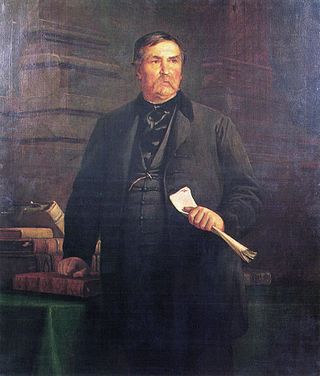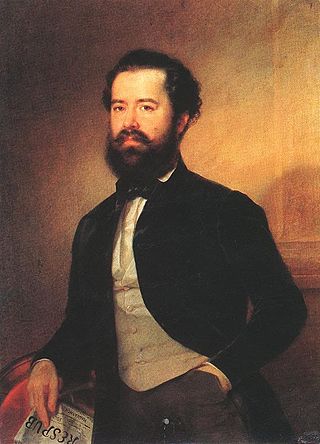
The Revolutions of 1848 in the Austrian Empire were a set of revolutions that took place in the Austrian Empire from March 1848 to November 1849. Much of the revolutionary activity had a nationalist character: the Empire, ruled from Vienna, included ethnic Germans, Hungarians, Slovenes, Poles, Czechs, Slovaks, Ruthenians (Ukrainians), Romanians, Croats, Venetians, and Serbs; all of whom attempted in the course of the revolution to either achieve autonomy, independence, or even hegemony over other nationalities. The nationalist picture was further complicated by the simultaneous events in the German states, which moved toward greater German national unity.

Lajos Kossuth de Udvard et Kossuthfalva was a Hungarian nobleman, lawyer, journalist, politician, statesman and governor-president of the Kingdom of Hungary during the revolution of 1848–1849.

The Austro-Hungarian Compromise of 1867 established the dual monarchy of Austria-Hungary, which was a military and diplomatic alliance of two sovereign states. The Compromise only partially re-established the former pre-1848 sovereignty and status of the Kingdom of Hungary, being separate from, and no longer subject to, the Austrian Empire. The compromise put an end to the 18-year-long military dictatorship and absolutist rule over Hungary which Emperor Franz Joseph had instituted after the Hungarian Revolution of 1848. The territorial integrity of the Kingdom of Hungary was restored. The agreement also restored the old historic constitution of the Kingdom of Hungary.

Ferenc Deák de Kehida was a Hungarian statesman and Minister of Justice. He was known as "The Wise Man of the Nation" and one of the greatest figures of Hungary's liberal movement.

Count István Széchenyi de Sárvár-Felsővidék was a Hungarian politician, political theorist, and writer. Widely considered one of the greatest statesmen in his nation's history, within Hungary he is still known to many as "the Greatest Hungarian".

The Diet of Finland, was the legislative assembly of the Grand Duchy of Finland from 1809 to 1906 and the recipient of the powers of the Swedish Riksdag of the Estates.

Count Lajos Batthyány de Németújvár was the first Prime Minister of Hungary. He was born in Pozsony on 10 February 1807, and was executed by firing squad in Pest on 6 October 1849, the same day as the 13 Martyrs of Arad.

The Imperial Council was the legislature of the Austrian Empire from 1861 until 1918. It was a bicameral body: the upper house was the House of Lords, and the lower house was the House of Deputies. To become law, bills had to be passed by both houses, signed by the government minister responsible, and then granted royal assent by the Emperor. After having been passed, laws were published in the Reichsgesetzblatt. In addition to the Imperial Council, the fifteen individual crown lands of Cisleithania had their own diets.

Péter Boross is a retired Hungarian politician and former member of the Hungarian Democratic Forum (MDF) who served as Prime Minister of Hungary from December 1993 to July 1994. He assumed the position upon the death of his predecessor, József Antall, and held the office until his right-wing coalition was defeated in election by the Hungarian Socialist Party (MSZP), which was led by his successor Gyula Horn. Prior to his premiership, Boross functioned as Minister of Civilian Intelligence Services (1990) and Minister of the Interior (1990–1993). He was also a Member of Parliament from 1994 to 1998 and from 2006 to 2009.

The Kingdom of Hungary between 1526 and 1867 existed as a state outside the Holy Roman Empire, but part of the lands of the Habsburg monarchy that became the Austrian Empire in 1804. After the Battle of Mohács in 1526, the country was ruled by two crowned kings. Initially, the exact territory under Habsburg rule was disputed because both rulers claimed the whole kingdom. This unsettled period lasted until 1570 when John Sigismund Zápolya abdicated as King of Hungary in Emperor Maximilian II's favor.

Bertalan Szemere was a Hungarian poet and nationalist who became the third Prime Minister of Hungary during the short period of the Hungarian Revolution of 1848 when Hungary was independent of rule by the Austrian Empire.
The Fundamental Law of Hungary, the country's constitution, was adopted by parliament on 18 April 2011, promulgated by the president a week later and entered into force on 1 January 2012. It is Hungary's first constitution adopted within a democratic framework and following free elections.

The Hungarian Revolution of 1848 was one of many European Revolutions of 1848 and was closely linked to other revolutions of 1848 in the Habsburg areas. Although the revolution failed, it is one of the most significant events in Hungary's modern history, forming the cornerstone of modern Hungarian national identity - the anniversary of the Revolution's outbreak, 15 March, is one of Hungary's three national holidays.

The revolutions of 1848, known in some countries as the Springtime of the Peoples or the Springtime of Nations, were a series of revolutions throughout Europe over the course of more than one year, from 1848 to 1849. It remains the most widespread revolutionary wave in European history to date.
The Hungarian Reform Era was a period of Hungarian history which led to the awakening of the Hungarian national identity after 150 years of Ottoman and 300 years of Habsburg rule. Its beginning was marked by the reconvening of the Diet of Hungary of 1825 and the foundation of the Hungarian Academy of Sciences. The era ended with the 1848 revolution and the ensuing Hungarian War of Independence.

The Principality of Transylvania, from 1765 the Grand Principality of Transylvania, was a realm of the Hungarian Crown ruled by the Habsburg and Habsburg-Lorraine monarchs of the Habsburg monarchy and governed by mostly Hungarians. After the Ottomans were ousted from most of the territories of medieval Kingdom of Hungary, and after the failure of Rákóczi's War of Independence (1703-1711), the Habsburg dynasty claimed the former territories of the Principality of Transylvania under the capacity of their title of "King of Hungary". During the Hungarian Revolution of 1848, the Hungarian government proclaimed union with Transylvania in the April Laws of 1848. After the failure of the revolution, the March Constitution of Austria decreed that the Principality of Transylvania be a separate crown land entirely independent of Hungary. In 1867, as a result of the Austro-Hungarian Compromise, the principality was reunited with Hungary proper.

The Slovak Uprising , Slovak Volunteer Campaigns or Slovak Revolt was an uprising of Slovaks in Western parts of Upper Hungary with the aim of equalizing Slovaks, democratizing political life and achieving social justice within the 1848–49 revolutions in the Habsburg Monarchy. It lasted from September 1848 to November 1849. In October 1848, Slovak leaders replaced their original Hungaro-federal program by Austro-federal, called for the separation of a Slovak district from the Kingdom of Hungary and for the formation of a new autonomous district within the framework of the Habsburg Monarchy.
The Sejm of the Grand Duchy of Posen was the parliament in the 19th century Grand Duchy of Posen and the Province of Posen, seated in Poznań/Posen. It existed from 1823 to 1918. In the history of the Polish parliament, it succeeded the general sejm and local sejmik on part of the territories of the Prussian partition. Originally retaining a Polish character, it acquired a more German character in the second half of the 19th century.

Like slavery, serfdom has a long history that dates to ancient times.

The Hungarian State was a short-lived state that existed for 4 months in the last phase of the Hungarian Revolution of 1848–49.

















